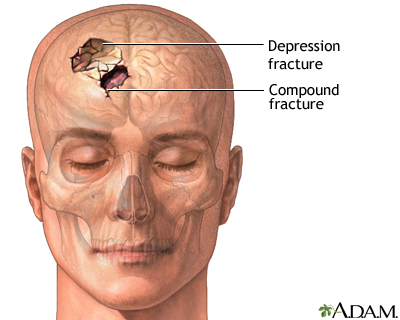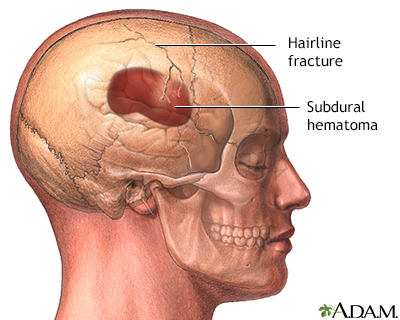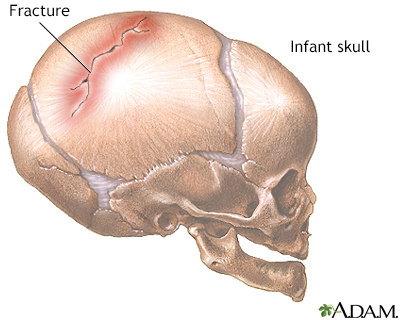Back From the Brink: How Matt Defied Death
Matt Benavidez can't recall how he ended up crumpled on a crosswalk on the night of Nov. 7, 2020. He has no memory of his motorcycle hitting an SUV or rescue…

Update your location to show providers, locations, and services closest to you.
A skull fracture is a fracture or break in the cranial (skull) bones.
Basilar skull fracture; Depressed skull fracture; Linear skull fracture
Skull fractures may occur with head injuries. The skull provides good protection for the brain. However, a severe impact or blow can cause the skull to break. It may be accompanied by concussion or other injury to the brain.
The brain can be affected directly by damage to the nervous system tissue and bleeding. The brain can also be affected by bleeding under the skull. This can compress the underlying brain tissue.
A simple fracture is a break in the bone without damage to the skin.
A linear skull fracture is a break in a cranial bone resembling a thin line, without splintering, depression, or distortion of bone.
A depressed skull fracture is a break in a cranial bone (or "crushed" portion of skull) with depression of the bone in toward the brain.
A compound fracture involves a break in, or loss of, skin and splintering of the bone.
Causes of skull fracture can include:
Symptoms may include:
In some cases, the only symptom may be a bump on the head. A bump or bruise may take up to 24 hours to develop.
Take the following steps if you think someone has a skull fracture:
Follow these precautions:
The health care provider will perform a physical exam. The person's nervous system will be checked. There may be changes in the person's pupil size, thinking ability, coordination, and reflexes.
Tests that may be done include:
Get medical help right away if:
Not all head injuries can be prevented. The following simple steps can help keep you and your child safe:





Bazarian JJ, Ling GSF. Traumatic brain injury and spinal cord injury. In: Goldman L, Schafer AI, eds. Goldman-Cecil Medicine. 26th ed. Philadelphia, PA: Elsevier; 2020:chap 371.
Papa L, Goldberg SA. Head trauma. In: Walls RM, Hockberger RS, Gausche-Hill M, eds. Rosen's Emergency Medicine: Concepts and Clinical Practice. 9th ed. Philadelphia, PA: Elsevier; 2018:chap 34.
Roskind CG, Pryor HI, Klein BL. Acute care of multiple trauma. In: Kliegman RM, St Geme JW, Blum NJ, Shah SS, Tasker RC, Wilson KM, eds. Nelson Textbook of Pediatrics. 21st ed. Philadelphia, PA. Elsevier; 2020:chap 82.
Matt Benavidez can't recall how he ended up crumpled on a crosswalk on the night of Nov. 7, 2020. He has no memory of his motorcycle hitting an SUV or rescue…
